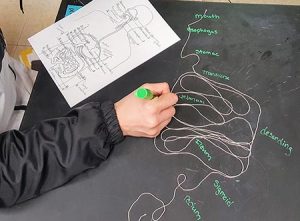
In this activity, students use string to model the gastrointestinal tract as a scale model. I’ve noticed that students do have difficulty with the concept of scaling, which is one of the crosscutting concepts listed in the NGSS.
The directions give students measurements for a 1/3 scale model, the human alimentary canal is about 9 meters long and this scale model is about 3 meters long. Students must measure and organize each section of the GI tract, which includes specific sections of the small intestine (duodenum, jejunum, ileum) and the large intestine.
I recommend students use their handouts to help them organize the sections. A common mistake is for students to want to make the model in one long line, and I usually correct this by saying “we’re not earthworms!” or “how tall would you be if your intestines just went straight down?”
It seems like such a simple concept, but I’m always surprised by how much they struggle with it.
I have students construct the models on their tables and label using chalk markers, but you can use a variety of different methods. The handout includes a outline of a person, and you could have students try to fit the GI tract within that outline, though that is harder than just using the table.
For string, I just purchase cheap twine, which is useful for other projects too. I cut the initial link, though not too exactly and even found a use for a box of random rib bones.

Grade Level: 9-12
Time Required: 20-30 minutes
HS-LS1-2 Develop and use a model to illustrate the hierarchical organization of interacting systems that provide specific functions within multicellular organisms
CCC3. Scale, proportion, and quantity. In considering phenomena, it is critical to recognize what is relevant at different measures of size, time, and energy and to recognize how changes in scale, proportion, or quantity affect a system’s structure or performance.

